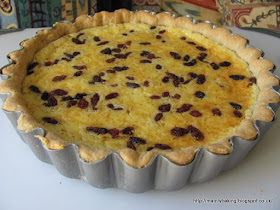 These Tropical Chocolate Cookies, flavoured with cocoa, vanilla, dried mango, flaked coconut and glacé ginger, are going into both the We Should Cocoa challenge (to pair chocolate and mango) and the Tea Time Treats challenge, which is to bake biscuits and cookies for tea this month.
These Tropical Chocolate Cookies, flavoured with cocoa, vanilla, dried mango, flaked coconut and glacé ginger, are going into both the We Should Cocoa challenge (to pair chocolate and mango) and the Tea Time Treats challenge, which is to bake biscuits and cookies for tea this month.These aren't dainty biscuits for a posh tea party, but hunky, chunky, chewy-centred cookies, for when you're sitting with a mug of tea and feeling guilty about watching day-time TV, or for handing out to the builders working in the yard as they take their umpteenth tea-break. But they are still a treat for whatever sort of tea-time you have!
 As FB was visiting again, and would be taking some home, I used my oil-based recipe from Cookie Madness. I substituted 25g of the flour with cocoa and added 30g flaked coconut, 80g chopped dried mango and 15g glace ginger, (which was in very small pieces) instead of the nuts and chocolate chips in the recipe. The total weight of additions to the basic dough was the same in both cases.
As FB was visiting again, and would be taking some home, I used my oil-based recipe from Cookie Madness. I substituted 25g of the flour with cocoa and added 30g flaked coconut, 80g chopped dried mango and 15g glace ginger, (which was in very small pieces) instead of the nuts and chocolate chips in the recipe. The total weight of additions to the basic dough was the same in both cases.Despite the strong flavours of each individual ingredient, these cookies were quite subtly flavoured - everything seemed to blend together to give an overall flavour which was quite delicate, with nothing being dominant. The mango and coconut flakes made the texture quite chewy too. All in all, these were very good - although they could probably have been improved by adding a handful of chocolate chunks!
 We Should Cocoa is a baking challenge started by Chele from Chocolate Teapot, and Choclette from Chocolate Log Blog. Each month a different ingredient is chosen to be paired with some form of chocolate in our cooking. This month the choice of mango was made by guest host Shaheen of Allotment to Kitchen, who will be posting a round-up at the end of the month.
We Should Cocoa is a baking challenge started by Chele from Chocolate Teapot, and Choclette from Chocolate Log Blog. Each month a different ingredient is chosen to be paired with some form of chocolate in our cooking. This month the choice of mango was made by guest host Shaheen of Allotment to Kitchen, who will be posting a round-up at the end of the month.Tea Time Treats is a monthly challenge co-hosted by Karen at Lavender and Lovage, and Kate at What Kate Baked. Karen chose this month's theme of cookies and biscuits. The name of the challenge is self explanatory, but more details can be found here.









